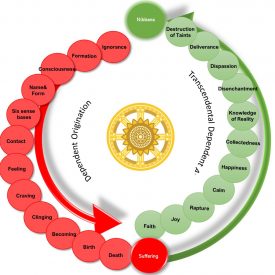This 6 days / 5 nights workshop retreat is a residential workshop in a retreat setting, the first of a kind, and led by Dhammacariya Sobhana (Delson Armstrong) in the beautiful Mary and Joseph Retreat Center near Los Angeles, USA.
This workshop is different and complementary to our traditional 10-day retreats for experienced TWIM meditators. In this workshop retreat, you will have the opportunity to learn both practical and theoretical details of Dependent Origination, one of the most important doctrines of the Buddha’s teaching.
This unique workshop is designed exclusively for experienced TWIM meditators to deepen their understanding of the twelve links of Dependent Origination, eleven links of Transcendental Dependent Arising, and complete realization of the four noble truths in each link. Please note – We will serve three meals on daily basis, we are taking only six precepts during the workshop.
The Teacher

Acariya (Delson) is a distinguished meditation and Buddhist studies teacher. He is regarded as a master meditation teacher in Tranquil Wisdom Insight Meditation. Since 2020 he has been teaching many online and residential retreats throughout Asia, Europe, and North America.
Acariya dedicates his life to teaching the path to liberation through the methodology laid out in the Buddhist suttas.
His latest book, A Mind Without Craving, offers a detailed exploration into the nature of reality, behavioural reprogramming, kamma, rebirth, consciousness, and liberation.
If you are interested in TWIM 10-days residential retreat in Califonia by Acariya, please check here.
Summary of program
- April 16, 2023- Day 1 (Registration, Group meditations, and Dhamma talk)
- April 17, 2023- Day 2 (Group meditations, Dependent Origination, and the Four Noble Truths workshop)
- April 18, 2023- Day 3 (Group meditations, Craving and Clinging workshop)
- April 19, 2023- Day 4 (Group meditations, Bhava, Rebirth and Kamma workshop)
- April 20, 2023- Day 5 (Group meditations, Formations, and Intention workshop)
- April 21, 2023- Day 6 (Group meditations, Transcendental Dependent Arising workshop, Ends @ 6 PM)

Prerequisites for Participants
• At least one 10-day full-time TWIM retreat (residential or online) is required. If you have never done a TWIM retreat before, please check out https://www.dhammasukha.org/ or http://suttavada.foundation/ or https://www.awakeninsightretreats.org/ for current retreat offerings.
• Must have a strong understanding of TWIM and proficiency in the 6R’s principles (we will not be covering this in this workshop retreat)
Retreat center


Mary & Joseph Retreat Center is in the city of Rancho Palos Verdes, Los Angeles County, California, (5300 Crest Rd, Rancho Palos Verdes, CA 90275, USA) high atop the hills and bluffs of the Palos Verdes Peninsula. Majestic views include the skyline of downtown Los Angeles, 23 miles to the northeast, and the entire Los Angeles basin. You can check out the facility and location here.

Accommodation

There are 28 single rooms with private bathrooms and 6 rooms with shared bathrooms. We will assign the single rooms on a first-come, first-served basis. Please check out more pictures here.
If you want a shared room with your family members, please contact us. The maximum number of meditators will be kept at 35.
Registrations, Costs, and Payment
The space is limited to 35 participants. The registration will open on July 1, 2022. You can send your email here to ensure you receive a reminder from us.
We are only charging the true costs of the retreat center, insurance, and transportation costs for the teacher. The teaching of the dhamma is always free of charge.
The cost is
- $975 / per person for single occupancy.
- $775 / per person for double occupancy – You must have someone to share with. We will allow a family member.
- A deposit of $300 will be required at registration. Deposits will not be refundable after December 31, 2022.
- The final payment will be due on February 28, 2023
Miscellaneous
Meals
- Three meals (breakfast and lunch, and light dinner) will be served daily from Day 1 to Day 6. (There will not be breakfast on Day 1)
- The retreat center will accommodate for mixed diet, vegetarian diet, gluten free diet. You can let us know your specific requests or notify us about any allergies in the registration form. The Retreat Center may not be able to accommodate all dietary requests. A microwave oven and refrigerator space are available for special foods you may need to bring with you.
Transportations
There will be no special group transportation. The Retreat Center is 17 miles away from the LAX Airport, and easily accessible by taxi or ride share services. Free parking is available at the site.
If you have any questions regarding this workshop retreat or any other retreats, please contact retreats.suttavada@gmail.com.

